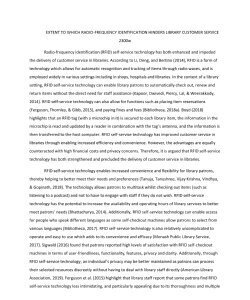EXTENT TO WHICH RADIO-FREQUENCY IDENTIFICATION HINDERS LIBRARY CUSTOMER SERVICE Radio-frequency identification (RFID) self-service technology has both enhanced and impeded the delivery o 2300w
EXTENT TO WHICH RADIO-FREQUENCY IDENTIFICATION HINDERS LIBRARY CUSTOMER SERVICE Radio-frequency identification (RFID) self-service technology has both enhanced and impeded the delivery o 2300w
EXTENT TO WHICH RADIO-FREQUENCY IDENTIFICATION HINDERS LIBRARY CUSTOMER SERVICE 2300w
Radio-frequency identification (RFID) self-service technology has both enhanced and impeded the delivery of customer service in libraries. According to Li, Deng, and Bertino (2014), RFID is a form of technology which allows for automatic recognition and tracking of items through radio waves, and is employed widely in various settings including in shops, hospitals and libraries. In the context of a library setting, RFID self-service technology can enable library patrons to automatically check out, renew and return items without the direct need for staff assistance (Kapoor, Dwivedi, Piercy, Lal, & Weerakkody, 2014). RFID self-service technology can also allow for functions such as placing item reservations (Ferguson, Thornley, & Gibb, 2015), and paying fines and fees (Bibliotheca, 2018a). Boyd (2018) highlights that an RFID tag (with a microchip in it) is secured to each library item, the information in the microchip is read and updated by a reader in combination with the tag’s antenna, and the information is then transferred to the host computer. RFID self-service technology has improved customer service in libraries through enabling increased efficiency and convenience. However, the advantages are equally counteracted with high financial costs and privacy concerns. Therefore, it is argued that RFID self-service technology has both strengthened and precluded the delivery of customer service in libraries.
Radio-frequency identification (RFID) self-service technology has both enhanced and impeded the delivery of customer service in libraries. According to Li, Deng, and Bertino (2014), RFID is a form of technology which allows for automatic recognition and tracking of items through radio waves, and is employed widely in various settings including in shops, hospitals and libraries. In the context of a library setting, RFID self-service technology can enable library patrons to automatically check out, renew and return items without the direct need for staff assistance (Kapoor, Dwivedi, Piercy, Lal, & Weerakkody, 2014). RFID self-service technology can also allow for functions such as placing item reservations (Ferguson, Thornley, & Gibb, 2015), and paying fines and fees (Bibliotheca, 2018a). Boyd (2018) highlights that an RFID tag (with a microchip in it) is secured to each library item, the information in the microchip is read and updated by a reader in combination with the tag’s antenna, and the information is then transferred to the host computer. RFID self-service technology has improved customer service in libraries through enabling increased efficiency and convenience. However, the advantages are equally counteracted with high financial costs and privacy concerns. Therefore, it is argued that RFID self-service technology has both strengthened and precluded the delivery of customer service in libraries.
